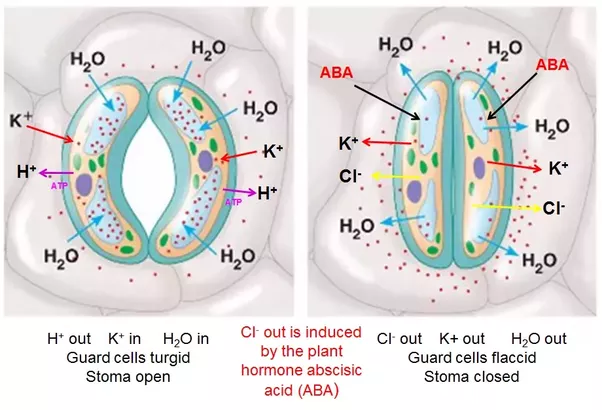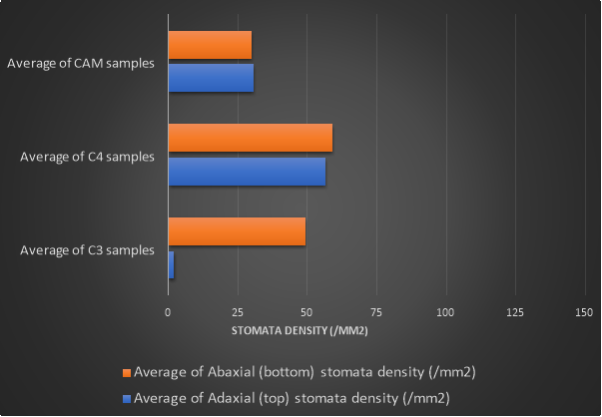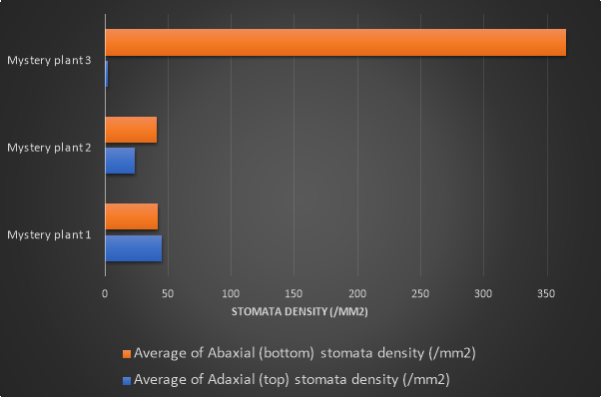Stomata Density and the Relationship to Plant Adaptions
| ✅ Paper Type: Free Essay | ✅ Subject: Biology |
| ✅ Wordcount: 3163 words | ✅ Published: 23rd Sep 2019 |
Observing Stomata Density and the Relationship to Plant Adaptions
Abstract
Stomata are vital for essential life processes. They are mostly found on plant leaves and open and close to regulate carbon dioxide intake for photosynthesis and water release. The following experiment analysed the differences in stomatal distribution of abaxial and adaxial leaf surfaces, and different photosynthetic pathways. Three different plants were analysed for the experiment. A layer of clear nail polish was applied to both the abaxial and adaxial leaf surfaces to observe the stomatal openings under a microscope. The number of stomata observed were then recorded and used to determine the relationship between the type of plant to classify the other two mystery plants. The results obtained were used to develop a correlation between the mystery plants and one of the 3 types of plants. It was found that mystery plant 1 was C4, mystery plant 2 was CAM and mystery plant 3 was C3.
Introduction
Stomata are found in the epidermis of vascular plants and are crucial for regulation of carbon dioxide for photosynthesis and preventing excessive water loss from transpiration. Stomata are crucial for gas exchange and in the respiration process, which allows the plant to release energy stored such as sugars from CO2 and water during photosynthesis (Shaw, 2018). Stomata are surrounded by two guard cells that are responsible for the opening and closing of the stomatal pores (Srivastava, 2002). Guard cells are triggered to open by high concentrations of potassium ions, as the water moves osmotically to the guard cells (high solute concentration) causing them to swell and open, allowing the plant to take in carbon dioxide. This results in the cells swelling and opening the stoma by changing its shape (Reference, 2019). Majority of stomata on land plants are found on the adaxial leaf surface, to reduce exposure to heat and air damage. Stomata are generally open during the day because this is when photosynthesis usually occurs. When the sunlight is no longer available and photosynthesis ceases, the stomata close. Stomata opening is controlled by factors such as light, plant carbon dioxide levels and environmental conditions. Under conditions where the most water loss is occurring by evaporation, the stomata must close to prevent dehydration. Humidity levels are an example of this environmental factor. If the humidity of the air around the plant decreases due to higher temperatures or wind, water vapour would transpire at an increased rate. To prevent this excess water loss, the plant’s stomata would close (Bailey, 2019).

Figure 1. Opening and closing of stomata in high and low solute concentrations. Arrows indicate movement into and out of the cell. Source: Fig 1 in Halmeck. (2016).
During photosynthesis plants must remove carbon from the atmospheric carbon dioxide and fix it, which makes it into organic molecules. There are three processes that plants use to fix carbon, C3, C4 and CAM (Biology Dictionary, 2018). Photorespiration occasionally makes an error, resulting in a wasteful metabolic pathway. This occurs when the carbon-fixing enzyme of the Calvin cycle, Rubisco, uses oxygen instead of carbon dioxide. This results in wasted energy as it uses up fixed carbon and tends to occur when stomata are closed. Some plants have adapted to overcome the negative effects of photorespiration. C4 and CAM plants have beneficial features due to natural selection, that contribute to a minimisation of photorespiration. They ensure that Rubisco is always exposed to high concentrations of carbon dioxide, making binding to oxygen less prominent (Khan Academy, 2019)
Get Help With Your Essay
If you need assistance with writing your essay, our professional essay writing service is here to help!
Find out more about our Essay Writing Service
C3 plants are the most common and make up 85% of plants. They do not have any photosynthetic adaptations to reduce photorespiration. This means to avoid errors with photorespiration they must be in areas of high CO2 concentration, moderate light and temperature intensity, and an abundance of water (Biology Online Dictionary, 2019). C4 plants have an extra process before the Calvin cycle, which reduces the amount of carbon lost overall. Light dependent reactions and the Calvin cycle are separated, with light-dependant reactions occurring in the mesophyll cells, and the Calvin cycle occurring in special cells called bundle-sheath cells. The oxygen content inside these specialised cells is very low, meaning Rubisco enzymes are less likely to catalyse oxidation reactions and waste carbon molecules (Biology Dictionary, 2018). Firstly, “atmospheric carbon dioxide is fixed in the mesophyll cells and is carried out by a non-rubisco enzyme, PEP carboxylase, that has no tendency to bind to oxygen. It is then converted to a similar molecule, malate, that can be transported in to the bundle-sheath cells. Inside the bundle sheath, malate breaks down, releasing a molecule of CO2. The CO2 is then fixed by rubisco and made into sugars via the Calvin cycle, exactly as in C3 photosynthesis.” (Khan Academy, 2019). 3% of land plant species use the C4 process, however dominate warm temperate zones such as grasslands in the tropics and subtropics. C4 plants prosper in long growing seasons with a great exposure to sunlight (Hirst, 2019). CAM plants have adaptations which allow them to survive in very dry and arid regions such as the desert. Over 5% of all land plant species use CAM as their photosynthesis process, and others can display CAM characteristics if required. CAM plants cannot keep their stomata open throughout the whole day as they will have too much water loss. They need to hold as much water as possible, so they open their stomata at night when there is less possibility of losing water (Hirst, 2019). When the stomata open at night, it allows the CO2 to diffuse into the leaves. This is then fixed into oxaloacetate by PEP carboxylase similar to C4 plants, then converted to a type of organic acid. Once converted, it is stored within the vacuoles until daylight, where they begin to photosynthesise without needing to open the stomata. This is completed by transporting the organic acid out of the vacuoles, breaking it down to release CO2, and slowly releasing it to the Calvin cycle. Therefore, CAM plants avoid photorespiration and are very water efficient (Khan Academy, 2018).
This study investigated the relation of stomata density to its plant adaptation. Specifically, 3 mystery plant’s stomata density was recorded, and then used to correlate between stomata density of C3, C4 and CAM plants to identify them. This investigated how stomata density relates to the 3 different plant processes.
Materials and Method
Experimental Method
6 specimens of C3, C4 and CAM plants were provided, as well as 3 mystery plants to investigate. 2 leaf samples around 2 inches long were cut from different parts of each plant. Inside a fume hood, a thick layer of clear nail polish was painted over a small area of each leaf sample, around 1 x 1 cm and avoiding major veins. This was done for both abaxial and adaxial surfaces of the leaf. After waiting approx. 5 minutes and the nail polish had dried, a square piece of clear tape was stuck to the area that contained the dried nail polish. Forceps were then used to gently peel the nail polish layer from the leaf surface. The leaf peel was then gently taped to a very clean slide, and scissors were used to remove any excess tape. This process was repeated until the upper and lower epidermis of 2 leaves from each plant specimen were generated on slides. All slides were labelled carefully to remember the plant it came from and whether it was the abaxial or adaxial leaf surface. The number of stomata in the section on the slide were then observed under a microscope and recorded.
Data analysis
This data recorded about the stomata on each sample was then entered into a data processor (Microsoft Excel). Due to variability in results due to environmental factors, the stomata density for each plant type and adaxial and abaxial surfaces were expressed as an average to negate any differences.
Results
The results from the average numbers show that mystery plant 1 was a CAM plant, mystery plant 2 was a C4 plant and mystery plant 3 was a C3 plant. The tables and graphs show a direct link between the known C3, C4 and CAM plants, and the mystery plants. The data is composed of 3 averages from 18 specimen data sets (6 from each plant) and the unknown plant data.
Table 1. AverageStomata Density Observed from Three different Plant Types.
|
Average of Adaxial (top) |
Average of Abaxial (bottom) |
|
|
stomata density (/mm2) |
stomata density (/mm2) |
|
|
Average of C3 specimen samples |
2 |
72.83 |
|
Average of C4 specimen samples |
56.50 |
109.83 |
|
Average of CAM specimen samples |
52.17 |
54.83 |
Table 2. Stomata Density Observed from Three Unknown Plant Types.
|
Average of Adaxial (top) |
Average of Abaxial (bottom) |
|
|
stomata density (/mm2) |
stomata density (/mm2) |
|
|
Mystery plant 1 |
45 |
42 |
|
Mystery plant 2 |
24 |
41 |
|
Mystery plant 3 |
2 |
365 |

Figure 2. Average Stomata Density Observed from Three different Plant Types

Figure 3. Stomata Density Observed from Three Unknown Plant Types.
Discussion
The results demonstrate that mystery plant 1 was a C4 plant, mystery plant 2 was a CAM plant and mystery plant 3 was a C3 plant. Mystery plant 1 is a C4 plant as it has more stomata than plant 2 (CAM) and a higher adaxial stomata density than plant 3 (C3). C4 plants have adapted to an alternative carbon fixation pathway to enhance the photorespiration cycle so the stomata do not have to remain open as often, therefore reducing the risk of dehydration and damage. C4 plants prosper in long growing seasons with a great exposure to sunlight, resulting in the higher density in stomata on the adaxial surface. Mystery plant 2 is a CAM plant. This is because it has the least number of abaxial stomata. CAM plants are found in extremely dry places and deserts and cannot keep their stomata open throughout the whole day as they will have too much water loss. They need to hold as much water as possible, so they open their stomata at night, meaning they don’t require as much stomata as the other, daytime plant species. Mystery plant 3 is the C3 plant. They must be in areas of high CO2 concentration, moderate light and temperature intensity, and an abundance of water. They have many stomata on the bottom of the leaf to obtain as much water as possible and to avoid direct exposure with sunlight.
These graphs also show many similarities. For example, both mystery plant 1 and the C4 plots on the graph show very little difference between adaxial and abaxial stomata density, and also both have the most adaxial stomata. Mystery plant 2 and the CAM data show that they both have the least amount of abaxial stomata and mystery plant 3 and the C3 data both show the most abaxial stomata (Khan Academy, 2018).
An advantage of stomata being on the abaxial surface is that they can efficiently regulate the amount of water within the leaf. This includes absorbing too much water in heavy rainfall or transpiring too much when under sunlight. A disadvantage to the stomata being found on the underside of a plant is seen in plants in areas with little sunlight. If stomata are found on the underside of plants and in areas of little sunlight, they may struggle to obtain the required amount of sunlight as they are heavily shaded. (Bailey, 2017). This is also an advantage to stomata on the top of a leaf. In areas with little sunlight, stomata on the top of a leaf will be in direct sunlight at some time, which will provide enough resources to the plant. A disadvantage of stomata being on the top of a leaf is that the plant may lose too much water as it is in direct sunlight (Science Forums, 2004).
It would be expected to find plants with a greater light exposure would have a greater stomatal density. This is because plants found in areas with greater sunlight would be able to thrive in its conditions, as long as it has other resources such as water readily available. Greater sunlight exposure would contribute to increased growth and photosynthesis rate, which can be completed more efficiently with more stomata.
Plants in moist environments would require more stomata. This is because “Plants move water from soils to leaves through a passive evapotranspiration process which provides more hydrogen ions for photosynthesis.” (Boyer, 2015). Therefore, water movement is completely reliant on stomata density and water availability. Moist environments have more stomata to ensure greater access to water (Boyer, 2015).
Leaf orientation directly affects stomatal traits. For example, a leaf that is horizontal will be able to have stomata on both top and bottom surfaces with an availability to sunlight, whereas upward and downward leaves may be heavily shaded or greatly exposed to sunlight in certain areas due to the orientation. This may cause damage to stomata cells because of too much sun exposure and dehydration due to higher transpiration rates, or may result in the stomata not receiving enough sunlight also damaging the plant.
Some data recorded was unexpected, which may be due to factors such as environment. For the C3 data sets, after performing an interquartile test specimen 4’s adaxial result and specimen 5’s abaxial result was removed as it was below the lower quartile standard deviation, and specimen 3’s abaxial result was removed as it was above the upper quartile standard deviation. For the C4 data sets, after performing an interquartile test specimen 2’s abaxial result was removed as it was above the upper quartile standard deviation. For the CAM data sets, after performing an interquartile test specimen 5’s adaxial and abaxial result was removed as it was outside of both deviation ranges.
Conclusion
Overall, the experiment was successful in identifying the mystery plants. It was identified that stomata density was directly related to plant adaptations. This was mostly due to the surrounding environmental effects that C3, C4 and CAM plants face.
References
- Bailey, R. (2019). What’s the Function of Stomata in Plant Tissue?. [online] ThoughtCo. Available at: https://www.thoughtco.com/plant-stomata-function-4126012 [Accessed 28 Jan. 2019].
- Biology Dictionary. (2018). C3, C4 and CAM Plants: Differences and Comparison. [online] Available at: https://biologydictionary.net/c3-c4-cam-plants/ [Accessed 29 Jan. 2019].
- Biology Online Dictionary. (2019). C3 plant – Biology-Online Dictionary. [online] Available at: https://www.biology-online.org/dictionary/C3_plant [Accessed 29 Jan. 2019].
- Halmeck, W. (2016). Why do guard cells have chloroplasts?. [online] Quora. Available at: https://www.quora.com/Why-do-guard-cells-have-chloroplasts [Accessed 29 Jan. 2019].
- Hirst, K. (2019). C3, C4, and CAM Plants: Adaptations to Climate Change. [online] ThoughtCo. Available at: https://www.thoughtco.com/c3-c4-cam-plants-processes-172693 [Accessed 29 Feb. 2019].
- Khan Academy. (2019). C3, C4, and CAM plants. [online] Available at: https://www.khanacademy.org/science/biology/photosynthesis-in-plants/photorespiration–c3-c4-cam-plants/a/c3-c4-and-cam-plants-agriculture [Accessed 29 Feb. 2019].
- Reference. (2019). What Causes the Stomata to Open and Close?. [online] Available at: https://www.reference.com/science/causes-stomata-open-close-72fc8cfa52ffb4cc [Accessed 28 Jan. 2019].
- Science Forums. (2004). Stomata on the upper epidermis of a leaf. [online] Available at: https://www.scienceforums.net/topic/5783-stomata-on-the-upper-epidermis-of-a-leaf/ [Accessed 1 Feb. 2019].
- Shaw, E. (2018). Definition of Plant Respiration. [online] Sciencing. Available at: https://sciencing.com/definition-plant-respiration-5655078.html [Accessed 27 Jan. 2019].
- Srivastava, L. (2002). Stomata – an overview. [online] Science Direct. Available at: https://www.sciencedirect.com/topics/earth-and-planetary-sciences/stomata [Accessed 27 Jan. 2019].
- Boyer, J. (2015). Why do plants with more access to water need more stomata?. [online] Research Gate. Available at: https://www.researchgate.net/post/Why_do_plants_with_more_access_to_water_need_more_stomata [Accessed 1 Feb. 2019].
Cite This Work
To export a reference to this article please select a referencing stye below:
Related Services
View allDMCA / Removal Request
If you are the original writer of this essay and no longer wish to have your work published on UKEssays.com then please click the following link to email our support team::
Request essay removal


